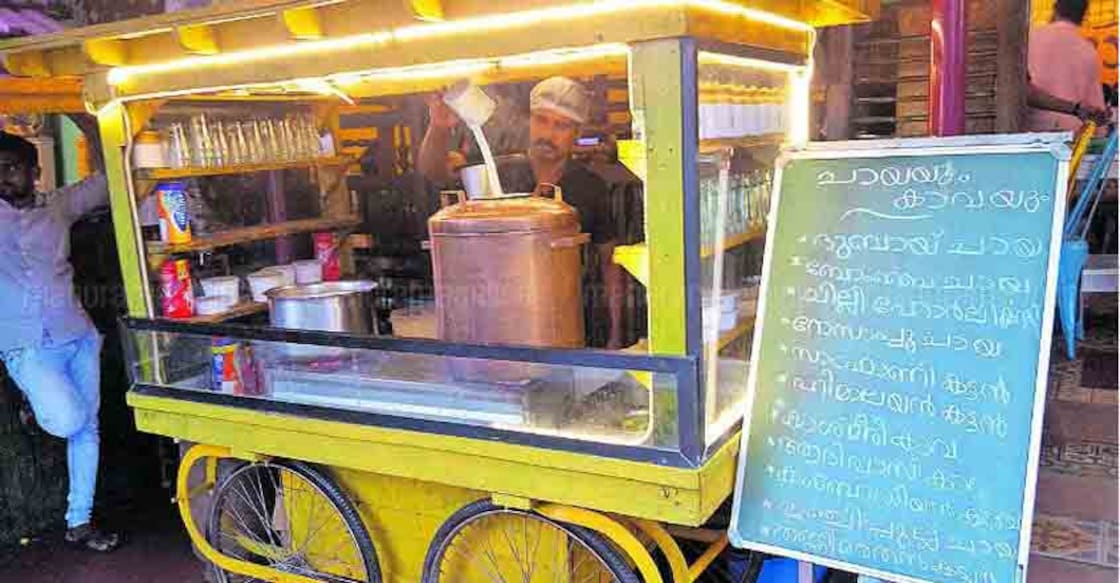Kava in Kozhikode is as cool as its ghazals

Mail This Article
Just like the waves from the sea, the tunes of music wafting from its shore into your ears are countless. I thought I should listen to some of them keenly, amid the blow of the evening breeze. Ah, this one I could make out the singer: Kozhikode Abdul Kader. The pitch of his voice is the giveaway; it can only be the Malayalam playback singer’s rendition emerging from a gramophone record. For once, I felt the needle running along the disc has a passionate gasp that adds to the rare rasp in the music.
It’s a Sunday, and so the crowd at Kozhikode’s South Beach is bigger than it is on weekdays. Actually, there is no elbow space to turn around in the thick gathering. It smells of love and compassion, yet I thought I could escape the dust and heat. And soon got into the Beach Road that will take me to the Gujarati street and Silk Street.
The Beach road’s interiors have a curious old-world charm. Backward, each of such pathways flows into first ripples of the Arabian sea. From its shore, I chose to turn eastward and walk down the Dawood Bhai Kapasi road. This road has several buildings that look like relics of a bygone era. Quite a few of the tile-roof halls used to double as cultural joints that hosted umpteen musical evenings. It is in their interiors that this Malabar city has had its first brush with north Indian music which wafted around as ghazals in stronger decibels in the last century.
Besides Abdul Kader, Kozhikode continues to boast of late Bombay S Kamal, who, like another vocalist Sharatchandra Marathe, added to the charms of the city’s reputation as a south Indian island of Hindustani music that has its roots upcountry. If the list of such ‘refugee’ artistes is long, so are the musical nights that enlivened the city. Is there a strain emanating from the upper floor of the Bombay Hotel by this path? Do I hear that grainy voice of the man who breathed his last 40 years ago? Of composer-vocalist M S Baburaj, who gifted Malayalam cinema many a golden hit till his untimely death in 1978?
It’s all just the aspirations of the mind. Babukka, as he was and is fondly called by fans, was virtually a myth even during his life that spanned just 49 years which wass also spent in Bengal, Bombay and even Ceylon.
From Kapasi Road, a left turn takes me to the Silk Street. It’s an alleyway that seemed to brim with the vibrancy of an imagined past. It’s not just the scent of silk that lingers around; there is also cinnamon hanging in the air. And also, attar, the famed Arabian perfume. It’s a heady mix bordering on the surreal.
The road leads to the old office of the municipal corporation. The crossroad has a statue of Mahatma Gandhi, striking the posture of an ascetic as usual. The Father of the Nation, whose independence struggle had once taken a whole lot of his compatriots to a seaside called Dandi in his native Gujarat in 1930. Times have changed a lot since, but not the loud whispers of the Arabian Sea. It’s something the sands of Kozhikode, too, can certify. As yet another ghazal from my list of favourites echoed in my ears, I walked a few steps forward — largely aimlessly. That was when I saw it: Adam’s Tea Stall.
Kava taste is musical
Ghazals are, after all, among the lighter genres of Hindustani classical. So, I shouldn’t go now for heavy food; that will only spoil the mood. In front of that restaurant stood a hand-pulled cart decorated tastefully. Even the seats alongside it bore multicolour paintings. The menu, seen here as a board that featured a chalk-written list of foods being served, invited my attention to just one item: kava.

Its popular in Malabar and has links with music. After all, the cuisine is this part of the country is not just about the food ingredients; they are as much a part of one culture or the other. It’s no coincidence that this beverage would be as cool as a ghazal.
It takes only minimum imagination to see around you elements from a richer past that wasn’t that far away from the modern times. A kava sipped in, sitting next to the flickering yellow glow of a hurricane lamp even as the strains from a classic ghazal linger around.
Ever tried Kava? Come on, this is no black tea or even the Sulaimani that Kozhikode often boasts about as part of hits cosmopolitan legacy. This brew has come from the northern parts of the country. Something that’s even more exhilarating than what we stylishly call green tea.
Kava is a corruption of the traditional drink called kaahva that is popular along a grand stretch of geography right from the deserts of West Asia to Afghanistan to Pakistan to the green ruggedness of Kashmir Valley today. It’s another matter that Kava is effectively a local drink in Kozhikode.It’s no guest, but a host. For many in Malabar, it’s customary to sip in Kava along with the rice-and-meat Dum Biryani that is prepared by steaming over coal. Kava tea actually washes down the kind of kick the food can give you. No surprise, because the drink, brewed in the Russia-origin copper Samovar tea urn, is a concoction of saffron, badam, honey, clove, cardamom and crushed almonds added with spoons of tea to boiling water.
As the body is no more enervated, I wonder if it was just the kava that did the magic. Outside, the ghazals tended to blend with the sound of the sea.

